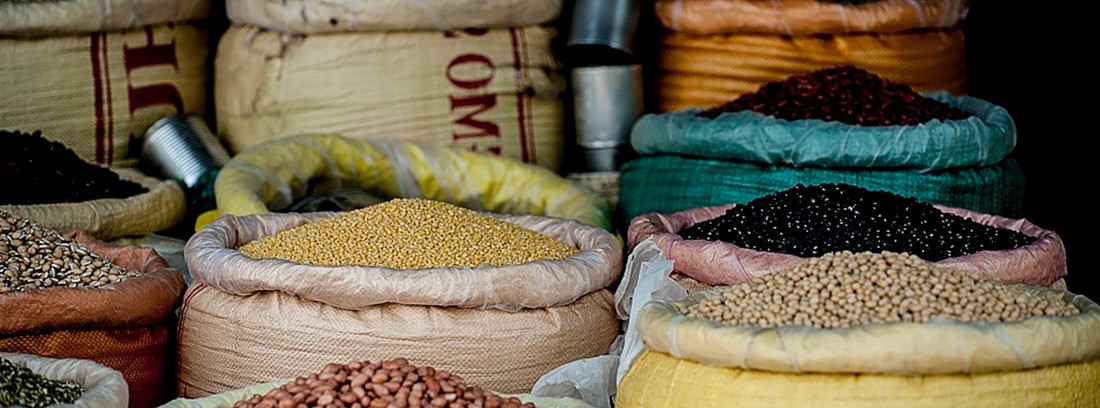Legumes, how to eat them?

Legumes are foods of great nutritional value, although many times they are banished from the usual diet since it is associated with the traditional winter stew, sometimes not well accepted, especially by the smallest of the house. In recent years, its consumption has been greatly reduced, being the average once a week.
In winter it lends itself to preparing spoon dishes, stews, stews ... where legumes are the real stars, and in summer we can prepare very versatile dishes where legumes can enhance all their flavor, although any of the preparations are ideal throughout the year. Among the most prominent legumes we find: lentils, chickpeas, white beans, beans, peas, broad beans, soybeans ...
What are the benefits of legumes for the little ones?
High content of vegetable protein: together with the dried fruit it is the richest plant food in protein, with about 20-30 grams per 100 grams of food, being an excellent option combined with cereal to obtain a high quality protein.
High content of complex carbohydrates: it provides between 40-50 grams per 100 grams of food, being an excellent food that provides energy gradually for the little ones.
Very rich in they provide between 10-20 grams per 100 grams of food, which helps improve intestinal transit and provides satiety. On the other hand, his high fiber content makes them more flatulent. For people who do not consume them regularly, it is advisable to incorporate them gradually and in small amounts.
Good source of vitamins and minerals, especially folic acid, B vitamins, calcium, phosphorus, iron, magnesium ...
How many legumes should we eat?
A minimum consumption of 2 times a week is recommendedThe ration for adults being 60-80 grams raw, adaptable to children depending on age. The amounts of carbohydrates are indicative depending on the, but these amounts can guide us: 30-40 grams in small children, 50-60 grams in children 8-11 years, and 80-90 grams in adolescent children. Remember that for any consultation made with food, it has the best specialists in dietetics and nutrition.
How to make legumes more appetizing?
For children, the varied colors are very attractive, on the contrary, the pasty appearance tends to cause rejection, so the presentation of the dish plays a fundamental role in turning the legume dish from unwanted to appetizing. So although a good legume stew can be delicious for adults and children, for those children who reject legumes we can make them like them by preparing other different and attractive recipes:
Tuna stone
Ingredients (4 people): - 800g cooked white beans - 1-2 can of tuna in extra virgin olive oil (to taste) - 2 small onions - 1 clove garlic - Black olives - Chopped parsley - Extra virgin olive oil - Vinegar - 1/2 teaspoon mustard - Salt and pepper
preparation: Drain the beans once cooked, mix them in a bowl with the tuna previously shredded with the onion, garlic, and finely chopped parsley. Mix the oil with the vinegar and mustard. Season with salt and pepper and add the beans. Let it marinate for an hour, stirring from time to time. Serve decorated with the black olives.
Lentil Burger
Ingredients: - 250 g of - 5 g of whole wheat flour - 1 onion - 3 garlic cloves - Extra virgin olive oil - Salt and parsley
preparation: Once the lentils are cooked, drain them and pour them into a bowl. With a fork or a mixer we work them until we get a paste. In another bowl, mix the grated onion, finely chopped garlic, salt, parsley and flour. Add this mixture to the lentil paste and mix until a dough forms. Let it rest for a few minutes. Form the burgers with your hands (we may need breadcrumbs or flour to facilitate the shape), fry them on both sides until golden brown.
Hummus
Ingredients: - 250 g chickpeas - juice of 2 lemons (or according to taste) - 3 tablespoons of tahini - 1 garlic clove, smashed - 1 teaspoon salt -
preparation: Once the chickpeas are cooked, drain them and pour them into a bowl. Beat the chickpeas with the cooking water until a homogeneous puree is created. Add the Tahini, the peeled and crushed garlic clove, add the lemon juice and the tablespoon of salt. Mix for 3-5 minutes with a fork until smooth. Serve on a plate and add the olive oil to taste. Serve with fresh pita bread or carrot or celery sticks.
Legume croquettes
Ingredients: - 1 cup of legumes to taste (although chickpeas or lentils are the most suitable) - 1 onion - Garlic - 1 carrot - Cumin powder - Parsley - Egg - Bread crumbs - Extra virgin olive oil
preparation: Peel and chop the onion, carrot and garlic. Sauté with oil for 3 minutes. We crush the previously cooked vegetables. Add the garlic and onion, finely grated carrot, parsley, salt and cumin. Mix until you have a consistent and compact dough. If it is too soft, flour can be added (preferably whole wheat). Shape into a croquette, pass the dough through the egg and coat them with the bread. They can be fried or baked.
- A minimum consumption of twice a week is recommended, being 60-80 grams raw the ration for adults, adaptable to children depending on age.
- Legumes have a high content of so, when combined with a cereal, it allows us to obtain a high quality protein.
- For children, the varied colors are very attractive, so the presentation of the dish plays a fundamental role in turning the vegetable dish into something appetizing.
Monica Carreira
Diploma in Human Nutrition and Dietetics Specialist in pharmacology, nutrition and sports supplementation
(Updated at Apr 14 / 2024)